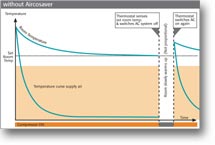Shortcomings of typical AC systems
A typical cooling cycle
When switched on, typical air conditioning systems operate continuously until the room thermostat senses the desired temperature and turns the system off. As the room warms up, the thermostat switches the air conditioner back on and the cycle repeats.
Most air conditioning systems are oversized for the majority of operating conditions
Air conditioning systems are usually dimensioned to cope with the extreme cooling demands of the few hottest days of the year (plus a safety margin).
However, in most operational conditions, this maximum output is not required and the system is oversized. So running the system continuously until the room thermostat switches it off means that the system operates with excess capacity most of the time.

A typical cooling cycle with excess capacity looks like this:
- When the cycle starts, the compressor pushes cooling energy into the heat exchanger which acts as an energy storage. At this stage, the system works with high efficiency because compressors operate most efficiently when fully loaded.
- In normal weather conditions, the energy storage is soon fully „charged up“. From this point onwards, the compressor provides more cooling energy than the heat exchanger can take up (thermodynamic saturation).
- Running the compressor beyond this stage does not increase the cooling effect any more. It’s just a waste of energy!